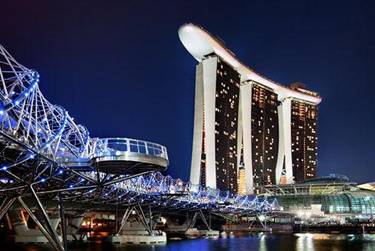LNG Shipping Frontrunners Meet at Marina Bay Sands, Singapore on 26-27 April 2012 to discuss IGF codes, growth of Chinese shipbuilders and fight for LNG shipping control in the face of tripling orders for new carrier designs
Singapore (4 April 2012) - Increasing environmental pressure, few qualified ships, bunkering system, regulatory ncertainty,
growth of Chinese shipbuilders and the impact of the Great East Earthquake exacerbate the challenges faced by the LNG shipping industry. LNG transportation front runners gather at LNG Shipping Summit 2012 in Marina Bay Sands, on 26627 April 2012 to limn the issues surrounding the LNG shipping business that allow industry not to speculate but have an informed decision on managing the business.

Figure 1: The LNG shipping industry meets at Marina Bay Sands on 26-27 April 2012 as Singapore celebrates its Maritime Month.
2012 marks the growth of LNG shipping industry, resulting largely from the growth of Chinese and Japanese demand for this cleaner fuel, surging 66 percent to 5.5 million tons last year from a year earlier, now believed to rise to 25 million metric tons and 39 per cent at 5.19 million metric tons of LNG last month, up from 3.73 million tons a year earlier, respectively.
LNG is one of the few profitable sectors in the shipping industry, in contrast to dry bulk and tanker markets, which continue to suffer from oversupply and funding difficulties. About 104 ships are now on order according to MOL, world's largest fleet owner who will be present at the LNG Shipping 2012 International Conference.
"The supply and demand factors in LNG industry do not concern industry players as much," says Frank Mercado, Director at Center for Energy Sustainability and Economics, "Transportation is the issue for many LNG players we have interviewed, concerned whether there will be enough compliant LNG ships as emissionregulations for all ships continue to tighten."
Another challenge is the LNG bunker supply and demand. LNG bunker suppliers rely on demand to develop the supply infrastructure, while operators and owners require a supply before investing in a vessel that relies on that supply. In addition, the costs of bunkering an LNG vessel are not necessarily known as there is not a large existing market for small volumes of LNG to be used on gas fuelled ships." The cost and availability of alternatives to ordinary heavy fuel oil, including LNG, potentially will change over the coming decade. All of this has to be weighed against the relative capital expenditure among competing fuel type concepts," reports ABS.
Chairing the LNG Shipping Summit on 26627 April 2012 is LNG shipping veteran Kenneth Wilson, principal of K C Wilson and Associates. He will further highlight the impact of the Great East Earthquake on the shipping industry as Japan replaces its lost nuclear power.
The summit will also discuss the rise of the Chinese shipbuilders as well as the use of LNG as ship fuel in the face of stricter environmental codes. Using LNG as ship fuel will reduce sulphur oxide (SOx) emissions, which are created when using fuel with a high sulphur content, by between 90% and 95%. This reduction level will become mandatory within the so6called Emission Control Areas (ECAs) from 2015. A similar reduction will be enforced for worldwide shipping from 2020 on, pending a review at the IMO.
Learn more about LNG Shipping 2012 at: http://www.arcmediaglobal.com/lngshipping
Arc Media Global is the world's first B2B/G2B integrated marketing specialist, with a mission to enable business development, innovation and sustainability in emerging markets' strategic sectors.
Contact:
Luc Men Hau
Marketing Manager
menhau@arcmediaglobal.com
P.O. Box 176, Robinson Road, Singapore 900326
T: +65 6844 2080
F: +65 6844 2060




